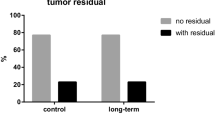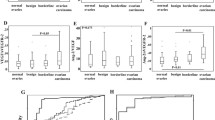Abstract
Advanced stage ovarian cancer has a high rate of recurrence even after surgery followed by chemotherapy combining carboplatin and a taxane. New strategies are currently under way to combat this situation and one of the most promising ones is based on the knowledge that angiogenesis, the mechanism of formation of new blood vessels coupled with the degradation of the extracellular matrix for metalloproteinases, could be crucial in the development of this tumor. The principal molecule implicated in angiogenesis process of ovarian cancer is the vascular endothelial growth factor (VEGF). Several studies are now in progress to clarify its role as a diagnostic tool or its therapeutic implication. Presently, there is no indication for the use of VEGF in a preliminary diagnosis seeing that an increase in levels can be seen in both benign and malignant ovarian conditions. VEGF is also responsible for an increase in vascular permeability and is directly related to symptoms such as ascites and pleural effusion, both of which are frequent in ovarian cancer. Several papers have analised the role of VEGF as a prognostic factor and some of them do confirm VEGF as an independent prognostic factor in ovarian cancer. VEGF and the metalloproteinase system coupled with angiogenesis are currently being evaluated as therapeutic targets but no positive results have yet to be seen in this field.
Resumen
El cáncer de ovario tiene un elevado porcentaje de recaída incluso tras un tratamiento agresivo que incluye cirugía seguida de quimioterapia combinando carboplatino y un taxano. Se están desarrollando nuevos métodos para resolver esta situación y uno de los más prometedores proviene de los nuevos conocimientos sobre angiogénesis, el mecanismo de formación de nuevos vasos sanguíneos, el cual unido al proceso de degradación de la matriz extracelular por las metaloproteinasas puede ser crucial para la expansión de esta neoplasia. La molécula más importante para la angiogénesis en cáncer de ovario es el factor de crecimiento vascular endotelial (VEGF). Se está evaluando su papel como medio diagnóstico y las posibles implicaciones terapéuticas. Hasta el momento no hay indicación para VEGF como herramienta diagnóstica en cáncer de ovario, ya que sus niveles pueden aumentar tanto en procesos benignos como malignos. El VEGF está implicado en la aparición de ascitis y derrame pleural. Varios artículos han demostrado la utilidad de VEGF como factor pronóstico en cáncer de ovario. La utilidad de VEGF como diana terapéutica y del sistema de metaloproteinasas se encuentra en fase de estudio.
Similar content being viewed by others
References
Carmeliet P, Jain RK. Angiogenesis in cancer and other diseases. Nature 2000;407:249–57.
Fox SB, Gasparini G, Harris AL. Angiogenesis: pathological, prognostic, and growth-factor pathways and their link to trial design and anticancer drugs. Lancet Oncol 2001;2:278–89.
Folkman J, Merler E, Abernathy C, Williams G. Isolation of a tumor factor responsible of angiogenesis. J Exp Med 1971;133:275–88.
Kerbel R, Folkman J. Clinical translation of angiogenesis inhibitors. Nature Rev Cancer 2002;2:727–39.
Rafii S, Lyden D, Benezra R, Hattori K, Heissig B. Vascular and haematopoietic stem cells: novel targets for anti-angiogenesis therapy? Nat Rev Cancer 2002;2:826–35.
Salven P. Angiogenesis in lymphoproliferative disorders. Acta Haematol 2001;106:184–9.
Ellis LM, Fidler IJ. Angiogenesis and metastasis. Eur J Cancer 1996;32A:2451–60.
Scappaticci FA. Mechanisms and future directions for angiogenesis-based cancer therapies. J Clin Oncol 2002;20:3906–27.
Dvorak HF. Vascular permeability factor/ vascular endothelial growth factor: a critical cytokine in tumor angiogenesis and a potential target for diagnosis and therapy. J Clin Oncol 2002;20:4368–80.
Ellis LM. Antiangiogenic therapy at a crossroads: clinical trial results and future directions. J Clin Oncol 2003;21(23 Suppl):281s-3s.
Eskens F. Angiogenesis inhibitors in clinical development; where are we now and where are we going? Br J Cancer 2004;90:1–7.
Cascinu S, Staccioli MP, Gasparini G, et al. Expression of vascular endothelial growth factor can predict eventfree survival in stage II colon cancer. Clin Cancer Res 2000;6:2803–7.
Shariat SF, Anwuri VA, Lamb DJ, Shah NV, Wheeler TA, Slawin KM. Association of preoperative plasma levels of vascular endothelial growth factor and soluble vascular cell adhesion molecule-1 with lymph node status and biochemical progression after radical prostatectomy. J Clin Oncol 2004;22:1655–63.
Adams J, Carder PJ, Downey S, et al. Vascular endothelial growth factor (VEGF) in breast cancer: comparison of plasma, serum, and tissue VEGF and microvessel density and effects of tamoxifen. Cancer Res 2000;60:2898–905.
Paley PJ. Angiogenesis in ovarian cancer: molecular pathology and therapeutic strategies. Curr Oncol Rep 2002;4:165–74.
Santin AD, Hermonat PL, Ravaggi A, Cannon MJ, Pecorelli S, Parham GP. Secretion of vascular endothelial growth factor in ovarian cancer. Eur J Gynaec Oncol 1999;20:177–81.
Stimpfl M, Tong D, Fasching B, et al. Vascular endothelial growth factor splice variants and their prognostic value in breast and ovarian cancer. Clin Cancer Res 2002;8:2253–9.
Otani N, Minami S, Yamoto M, et al. The vascular endothelial growth factor/fms-like tyrosine kinase system in human ovary during the menstrual cycle and early pregnancy. J Clin Endocrinol Metab 1999;84:3845–51.
Brustmann H, Riss P, Naudé S. The relevance of angiogenesis in benign and malignant epithelial tumors of the ovary: A quantitative histologic study. Gynecol Oncol 1997;67:20–6.
Olson TA, Mohanraj D, Carson LF, Ramakrishnan S. Vascular permeability factor gene expression in normal and neoplastic human ovaries. Cancer Res 1994;54:276–80.
Boocock CA, Charnock-Jones S, Sharkey AM, et al. Expression of vascular endothelial growth factor and its receptors flt and KDR in ovarian carcinoma. J Natl Cancer Inst 1995;87:506–16.
Zhang L, Yang N, Conejo-García JR, et al. Expression of endocrine gland-derived vascular endothelial growth factor in ovarian carcinoma. Clin Cancer Res 2003;9:264–72.
Zebrowski BK, Yano S, Liu W, et al. Vascular endothelial growth factor levels and induction of permeability in malignant pleural effusions. Clin Cancer Res 1999;5:3364–8.
Nagy J, Masse EM, Herzberg KT, et al. Pathogenesis of ascites tumor growth: vascular permeability factor, vascular hypermeability, and ascites fluid accumulation. Cancer Res 1995;55:360–8.
Contos J, Ishii I, Chun J. Lysophosphatidic acid receptors. Mol Pharmacol 2000;58:1188–96.
Hu YL, Tee MK, Goetzl EJ, et al. Lysophosphatidic acid induction of vascular endothelial growth factor expression in human ovarian cancer cells. J Natl Cancer Inst 2001;93:762–8.
Sowter HM, Corps AN, Evans AL, Clark DE, Charnock-Jones DS, Smith SK. Expression and localization of the vascular endothelial growth factor family in ovarian epithelial tumors. Lab Invest 1997;77:607–14.
Paley P, Staskus K, Gebhard K, et al. Vascular endothelial growth factor expression in early stage ovarian carcinoma. Cancer 1997;80:98–106.
Yamamoto S, Konishi I, Mandai M, et al. Expression of vascular endothelial growth factor (VEGF) in epithelial ovarian neoplasms: correlation with clinicopathology and patient survival, and analysis of serum VEGF levels. Br J Cancer 1997;76:1221–7.
Shen GH, Ghazizadeh M, Kawanami O, Shimizu H, Araki T, Sugisaki Y. Prognostic significance of vascular endothelial growth factor expression in human ovarian carcinoma. Br J Cancer 2000;83:196–203.
Tempfer C, Obermair A, Hefler L, Haeusler G, Gitsch, Kainz C. Vascular endothelial growth factor serum concentrations in ovarian cancer. Obstet Gynecol 1998;92:360–3.
Cheng CA, Cheng WF, Lee CN, et al. Serum vascular endothelial growth factor in epithelial ovarian neoplasms: correlation with patient survival. Gynecol Oncol 1999;74:235–40.
McGuire WP, Hoskins WJ, Brady MF, et al. Cyclophosphamide and cisplatin compared with paclitaxel and cisplatin in patients with stage III and stage IV ovarian cancer. N Engl J Med 1996;334:1–6.
Piccart MJ, Bertelsen K, James K, et al. Randomised intergroup trial of cisplatin-paclitaxel versus cisplatin-cyclophosphamide in women with advanced epithelial ovarian cancer: Three year results. J Natl Cancer Inst 2000;92:699–702.
Brown PD. Matrix metalloproteinase inhibitors in the treatment of cancer. Med Oncol 1997;14:1–10.
Eisenhauer E, Dancey J. Impact of new non-cytotoxics in the treatment of ovarian cancer. Int J Gynecol Cancer 2001;11(Suppl 1):68–72.
Hirte H, Vergote I, Jeffrey J, et al. NCIC CTG OV.12: An international multicentre phase III study of BAY 12-9566 (BAY) vs. placebo in patients with advanced ovarian cancer responsive to primary surgery/paclitaxel + platinum containing chemotherapy. [abstract]. Ann Oncol 2000;11 (Suppl 4):144.
Hussain MM, Kotz H, Minasian L, et al. Phase II trial of carboxyamidotriazole in patients with relapsed epithelial ovarian cancer. J Clin Oncol 2003;21:4356–63.
Eisen T, Boshoff C, Mak I, et al. Continuous low dose thalidomide: a phase II study in advanced melanoma, renal cell, ovarian and breast cancer. Br J Cancer 2000;82:812–7.
Abramson N, Stokes PK, Luke M, Marks A, Harris J. Ovarian and papillary-serous peritoneal carcinoma: pilot study with thalidomide. J Clin Oncol 2002;15:1147–9.
Author information
Authors and Affiliations
Rights and permissions
About this article
Cite this article
Carrión, L.A., Sánchez, F.J.G., Conejo, E.A. et al. The importance of angiogenesis in ovarian cancer. Rev Oncol 6, 462–467 (2004). https://doi.org/10.1007/BF02713082
Published:
Issue Date:
DOI: https://doi.org/10.1007/BF02713082




